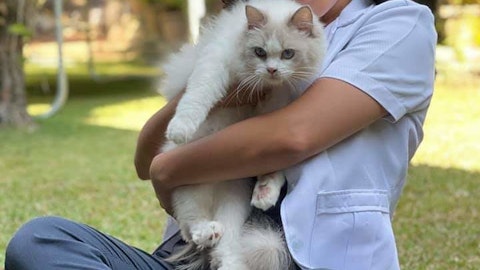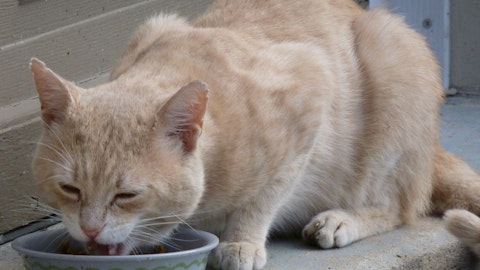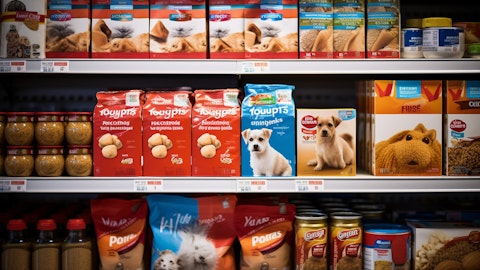Ron Coughlin: Yes, I would just build on Brian’s comment. When we spoke in Q3, we did not have line of sight to getting all these brands at the accelerated timing that we were able to get them in the quantities that we got them, which, obviously, is a positive, given the adjustment that we wanted to make. The broader comment I’d make is, we understand that EBITDA was below expectations. We recognize the importance of meeting our commitments. While there are market dynamics, there are things we can do better. And we’re attacking those and focus on driving improved execution. And that’s the operational reset that we talk about today. But we take these commitments very seriously.
Operator: Thank you. And the next question comes from Simeon Gutman with Morgan Stanley.
Simeon Gutman: Hey, good morning or — good morning, everyone. My first question, it’s on the top line. If we look at the deceleration we’ve seen this year and maybe even in part of last year, can you separate what you’re seeing in terms of reversion or how much of the slowdown is explained by discretionary reversion, a move to value for the category and then can you separate that out from the wallet share with your core customer?
Brian LaRose: Yes. Thanks, Simeon. First the implied guidance for Q4 is low single digits, which we believe is appropriate, given what we’re currently seeing. That does include the extra week. In terms of some of the drivers, we are lapping pricing from the second half of last year. So the inflation benefit that we, like others saw in the first half of the year is beginning to abate in the second half. So that is a driver. Secondarily, if you look at the discretionary business, it has continued to stay at kind of a minus 9% clip that we reported this quarter. And that’s off of a compare that was a bit easier. So arguably that’s a larger impact than last quarter on the top line.
Simeon Gutman: And then one quick follow-up. Can you share with us if you look back several years, maybe five years ago, before you moved upstream with product, what percentage of either the consumables business or the overall business did value brands represent?
Ron Coughlin: Yes, we’d have to get back to you on that. What I can tell you is, the value brands have grown significantly in the last two years, which is why we’re making the move. If you look at Super Premium, Fresh Frozen, as I said, they were the predominant drivers of growth in the category. Basically, since the second half of 2022 into 2023, we’ve seen strong double digit growth in the value brand. So they have scaled significantly from where they were back then. But we can follow up with you on that, Simeon.
Operator: Thank you. [Operator Instructions] And the next question comes from Steven Zaccone with Citigroup.
Steven Zaccone: Hi, good morning. Thanks very much for taking my question. Ron, I wanted to get your assessment if something’s changed in the overall pet industry. Premiumization has been a good category, but now you’re doing this pretty significant shift to focus on value. Do you think this is something that’s going to be a multi-year trend where maybe the consumer is going to have more of a high-low approach to the category? Thank you.
Ron Coughlin: Thanks for the question, Steve. So first, from a — if you look at the past decade plus, and if you look at projections going forward, there continues to be a projection of premiumization, humanization. Underneath that is the dynamic of more millennials and Gen Z’s adopting pets. And they spend more and they are more inclined towards premiumization, humanization. And you’ve seen some of the announcements on Fresh Frozen that reflect that, right? So we continue to see that. And on the food side of the business, we see a bifurcation. We continue to see strong growth on Fresh Frozen. We continue to see solid growth on super premium. What has really accelerated is value. Between those two is where the pinches come in the category, coupled with the discretionary spend that’s impacted supplies and companion animal.
But that bifurcation is real. We continue to believe and projections continue to show that Fresh Frozen, super premium will grow, which is why we have our portfolio, why we brought in products like [Ali] (ph). But there’s a short term impact of the value seeking that we’re responding to. And again, it is all about not only selling those products for customers that want those products, but it’s also about driving them into our ecosystem, getting the supplies, getting the services, getting the vital care premier signups, and which has a financial benefit in terms of gross profit dollars, speed to growth for us. But it also has a benefit for the pets, because in an unassisted environment that pet’s not going to get healthier. In our environment that pet is going to be healthier.
Steven Zaccone: Okay. And then the thought I had is more for Brian. Could you talk about the cash flow outlook for this year and then into next year, because you had the commentary about CapEx? And along those same lines, if you think about the building blocks to see EBITDA margin rate improve over time, could you walk through the biggest factors, because now you’re implementing this area — this assortment that’s a little bit more value and it’s a little bit lower margin. So do you really just see the discretionary side of the business to get better, to see even that margin rate improve? Thanks very much.
Brian LaRose: First on cash flow, Steve, let me comment on the quarter itself. Year-to-date, we are at roughly the same free cash flow as last year, even though earnings are down the way they are. And I think the team’s done an exceptional job managing working capital. [Fables] (ph) has been a big driver for us of working capital improvement. And I think on inventory, although we’re up slightly year-over-year, that team has just done a remarkable job. In stocks are up year-over-year, inventory turns are up year-over-year. So in terms of overall cashflow year-to-date, I’m pleased with where we are given the working capital management, not going to get into specific guidance on Q4 and in terms of 2024, we’ll come back with that on the Q4 call.
As for the building blocks of EBITDA, first of all, it’s all about customers and baskets. I mean, that is the primary driver. The expansion of the assortment that we announced just now is about getting more footsteps through the door, building basket with those customers, and getting them across the ecosystem. The second component of that would be cost. We talked about $150 million cost takeout. The first leg of that, the first $40 million we talked about in year one, is primarily OpEx and associated partially with the actions that we announced last quarter around headcount reduction. The next leg, when we get into second half 2024 and to 2025 and exit run rate, it has more to do with cost of sales across supply chain and the merchandise overall bucket of cost of sales.




